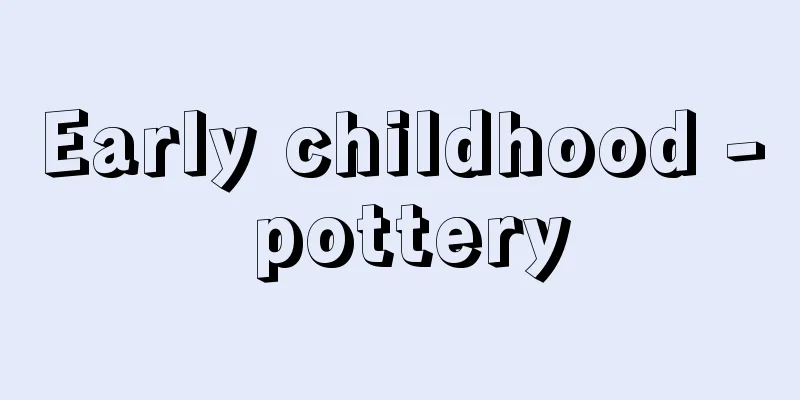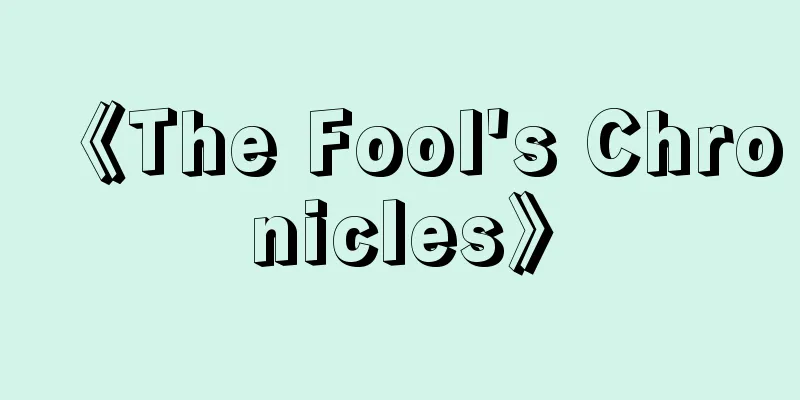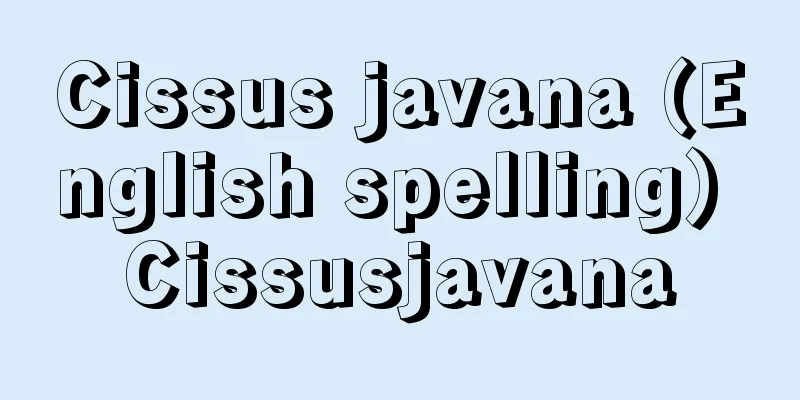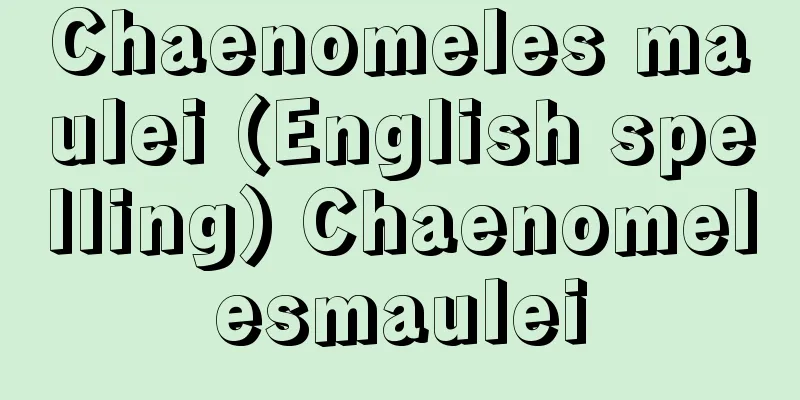Early childhood - pottery

|
Generally, it refers to the period from age one until starting school. Around age one, weaning is complete, children begin walking, begin to speak more, and acquire the qualifications of a human being. Thereafter, they will display their wonderful human abilities. This is a period in which the foundation of a person's personality is created, and for this reason the influence of parents in the home is particularly great. In this sense, it is important to appreciate the weight of the proverb "A child's character is formed by the age of three." In forming a child's personality, it is necessary to work hard at child-rearing to stabilize their emotions, support their development, and help them develop independence and become highly motivated children. [Nobuyoshi Hirai] LifestyleLifestyle habits become more independent as children get older. If you want your child to become independent, it is important to "leave it to them" when they are trying to act on their own initiative. If you leave it to them, they will make mistakes, be inefficient, and try and fail, but the attitude of leaving it to them is to watch them patiently. If you can no longer watch and you speak up, you will end up interfering or giving orders, and if you help them, you will come across as overprotective, which will hinder the development of their initiative. Among daily habits, children are able to eat meals with almost no help from adults between the ages of 4 and 5. However, during this time, they will go through a process of eating with their fingers, tipping over their bowls, playing with their food, and so on. This is because development is carried out while swaying back and forth. Parents are required to be tolerant of this. Between the ages of 18 months and 2 years, children begin to announce when they will need to go to the toilet by saying "poop" or "pee," but accidents become less frequent around the age of 28 months. If you rush to train your child to go to the toilet, they may resist and end up having more accidents, or they may even develop diurnal enuresis (wetting themselves), bedwetting, or frequent urination. In Japan, there is a general tendency to rush to train children to go to the toilet, but even in this regard, it is important to respect the child's own initiative and to make sure that any accidents are not caused. Around 70% of children stop wetting the bed by the age of 3, but some children continue to do so until they reach school age. Even if bedwetting causes harm, it is best not to blame the child. Sleep is not a problem for children who are very active during the day. However, they like to bring various things into their bed and have their mother stay close to them to listen to stories and lullabies. Having their mother by their side stabilizes their emotions and helps them sleep soundly. Especially between the ages of 18 months and 28 months, children may crawl into their mother's futon in the middle of the night and ask to sleep next to her. They may have had a frightening dream, but at such times it is best to sleep next to them without hesitation. This is also a good way to strengthen the emotional bond between mother and child. In a country like Japan where earthquakes and fires are frequent, it is safer to let children sleep in the same room as their parents until they start elementary school. If you start letting your child take on more of the act of putting on and taking off clothes from around age 2, they will be almost completely independent by the time they reach age 4 or 5. Parents should try to help them become independent as little as possible. They may play in their underwear or start doing other things naked, but it is important not to rush them and tell them to hurry up. When they reach toddler age, they will be able to do a lot of bathing on their own. However, it should be remembered that children enjoy bathing because they can play in the water. Rather than just thinking about keeping clean and warm, it is important to make sure they are able to play in a fun way. Other hygiene habits include washing the face, brushing teeth, washing hands, and gargling. Even if they are not good at it at first, it is best to let children take charge of these things. In doing so, it is desirable for parents to show them how to do it and to introduce play to make it fun. When it comes to discipline, we often use imperative pressure, and if a child is lazy or starts playing in the middle of their routine, they are often scolded. As it is said that children's play is both life and learning, it is necessary to allow and introduce play when discipline is being taught. Not rushing discipline leads to true independence. Discipline through imperative pressure is completely useless when there is no one to give orders. [Nobuyoshi Hirai] Materials and teaching materialsEducational materials given to young children include toys, play equipment, picture books, stationery such as crayons and drawing paper, and many other commercially available items. However, it must not be forgotten that the most important material for children is nature. Nothing in nature is the same, so it is not possible to provide a uniform education. The use of natural objects also gives children the opportunity to become familiar with the soil. This can be said to be the first step in getting to know nature. For this reason, playing in the mud is encouraged. In addition, waste and junk are good materials for children, which they can use freely. First of all, the fact that they are free makes parents feel at ease. If you have anything you want to throw away, such as advertising paper, cardboard boxes, scraps of wood, or styrofoam, it is a good idea to put them in a large box. With scissors and cellophane tape or duct tape, children can make swords or spears, or create houses, airplanes, ships, castles, or anything else that comes to their mind. Watching this shows how creative children are, and parents can enjoy it too. Even if they break it, it's all the same, and they can be replaced over and over again. However, it is a good idea to treasure and display the things that children make. Picture books are good teaching materials for expanding various imaginations from the pictures. However, children who have been taught to read do not look at the pictures. In other words, it can be said that their emotional development is blocked. It is also important for parents to read fairy tales to their children. The voice stays in their ears forever. Moreover, if the child likes, the same story can be read over and over again, and it can be interesting to read it in different ways depending on the mother's mood at the time. In that respect, commercially available tapes are always the same and are not useful for expanding imaginations. Sandboxes are also good teaching materials for outdoor play, because they allow for a variety of creative activities. When considering the development of a child's personality, it is necessary to think of materials and teaching materials that allow children to play spontaneously and expand their imaginations, but it is also necessary to always take them outside so that they have plenty of natural access. Children are beings with infinite potential, and because they are naturally rich in creativity, we should make an effort to provide them with materials and teaching materials that draw out their potential and do not suppress their creativity. [Nobuyoshi Hirai] Sensorimotor IntelligenceA notable feature of intellectual development in early childhood is the emergence, expansion, and active functioning of images. It is true that a one-year-old infant does not yet have images, and performs intellectual functions based solely on sensory-motor activity. However, compared to that of an infant, their sensory-motor intelligence is far more differentiated and functions in a more diverse and flexible manner. For example, the circulatory response of repeating the same movement is not merely a mechanical repetition, but is deliberately regulated, and the movement and the resulting changes in sensation are carefully examined. This kind of exploratory activity is gradually internalized, and progresses to a solution behavior that involves trial and error in the mind, even in difficult situations, without actually taking action. In this way, images begin to appear around the age of two, and the child enters the period of representational thinking. [Takehisa Takizawa] Representational ThinkingThe emergence of images is linked to the development of the ability to manipulate symbols. In fact, from this stage onwards, children are able to think using substitute symbols instead of real objects. Children's play also becomes more symbolic, like pretend play, rather than simply active play, and they begin to make efforts to draw things that resemble the real thing, rather than simply sketching them. However, unlike conceptual thinking, thinking through images is not bound by logical frameworks. This allows the imagination to run wild in the minds of young children. As a result, they sometimes even lose the ability to distinguish between their inner and outer worlds. This is where the egocentrism that is so characteristic of young children comes into play. For example, in order to compare everything to the infant itself, the infant may consider even inanimate objects to be alive (animism), may regard the products of purely internal thinking such as dreams and imagination as objective reality (idealism), or may be unable to distinguish between natural and artificial objects and believe that everything was made by human beings (artificiality). Egocentrism is also expressed in language activities as egocentric speech, such as talking to oneself. [Takehisa Takizawa] Preconceptual and intuitive thinkingThe representational thinking stage is divided into a period of preconceptual thinking up to around age 4, and a period of intuitive thinking up to around age 6 or 7. Preconcepts are concepts with a very specific character that exist before concepts with a general character are acquired. Therefore, their meaning is unstable, and they can refer to a class or an individual. Because infants think in terms of preconcepts, they display the kind of derivative reasoning that is typical of infants, deriving specific conclusions from specific premises. For example, an infant might think that because they can ride a tricycle, their mother can also ride a tricycle, which is illogical thinking from an adult's perspective. Eventually, these preconcepts develop into concepts, but even after the age of four, representations are unstable and perception takes precedence over logic. As a result, intuitive thinking, which is governed by the appearance of things, dominates this period. The reason why an infant's quantitative perception lacks conservatism is because they judge the size of objects based on appearance alone. To go beyond intuition and grasp the relationships behind appearances, an infant needs operational thinking that works based on logical structures. The early childhood period is a process of approaching this operational thinking step by step. [Takehisa Takizawa] The emergence of self-consciousnessEarly childhood is also a time when a sense of self emerges and develops. Particularly around the age of three, children begin to feel restricted by adult care and strive to become independent. This is known as the rebellious period (the first rebellious period) as rebellious behavior is particularly noticeable, but this is also the time when children begin to refer to themselves in the first person and to assert ownership by saying "mine." Normally, rebellion becomes less prevalent by the age of four, and instead, children start to show signs of trying to make themselves look as beautiful as possible to others. This is an expression of a desire to confirm their self-identity by receiving praise from others, and this period is known as the grace period. Furthermore, at the age of 5, children move on to the mimetic stage, where they actively try to expand their ego by imitating the behavior of adults. This series of stages in the development of ego consciousness is also an important period for the formation of a child's personality. In particular, the development of self-control abilities that accompanies the development of the ego makes it possible for children to smoothly carry out joint activities in groups. [Takehisa Takizawa] Social DevelopmentAt first, children mainly play alone. Even if they happen to play with other children, each child will do what they want, and fights will soon break out. However, through fights, young children become aware of the existence of others and their own limitations, and eventually begin to think from the other person's point of view. This helps to eliminate egocentrism. Also, as they become able to restrain what they want to do, they become aware of the existence of group rules. Thus, children's play becomes more cooperative (play with rules), in which they pursue common goals while respecting the rules. Therefore, it can be said that social development is inseparably linked to intellectual and personality development in early childhood. [Takehisa Takizawa] "Lectures on Child Psychology, edited by Tamotsu Fujinaga and Kiyosumi Takano (1975, Nihon Bunka Kagakusha) " ▽ "Childhood and Society, by Erikson, translated by Eizaburo Kusano (1974, Nihon Kyobunsha)" ▽ "Encyclopedia of Child Rearing and Discipline, by Nobuyoshi Hirai (1979, Shogakukan)" ▽ "Educational Theory, by Minoru Kuroda (1979, Sogensha)" [Reference] | | | | | |Source: Shogakukan Encyclopedia Nipponica About Encyclopedia Nipponica Information | Legend |
|
一般的には、1歳から就学するまでの時期をいう。1歳前後に離乳が完成し、歩行が始まり、話しことばが多くなり、人間としての資格が整うと、その後、人間としてのすばらしい能力を発揮していく。とくに、人格の基盤をつくる時期であり、それだけに家庭における両親の影響は大きい。その意味で「三つ子の魂、百まで」という諺(ことわざ)のもつ重みをかみしめる必要がある。人格形成にあたっては、情緒の安定を図り、その発達を援助し、自主性の発達とともに意欲の盛んなる子供になるように、育児に精を出す必要がある。 [平井信義] 生活習慣生活習慣は、年齢の上昇とともに自立していく。自立を願うならば、子供が自発的に行動しようとしているときには、子供に「まかせる」ことがたいせつである。まかせてみると、子供は、失敗をしたり、能率の悪い状態を呈したり、試行錯誤を重ねるが、それをじっとみているのがまかせる態度である。ついみていられなくなって、口を出せば干渉や命令になるし、手を貸せば過保護になり、自発性の発達は阻害される。 生活習慣のなかで、食事は、4歳から5歳の間に、ほとんど大人の援助を必要としないで食べることができるようになる。ただし、その間に、手づかみにして食べたり、茶碗(ちゃわん)をひっくり返したり、途中で遊んでしまったりするなどの経過をたどる。発達は、右に揺れ左に揺れながら実施されるからである。それに対しては寛容な親であることが要請される。 排尿便は、1歳半から2歳の間に「ウンコ」とか「オシッコ」といって予告するようになるが、失敗が少なくなるのは2歳半前後である。排尿便のしつけを急ぐと、それに抵抗して、かえって失敗が多くなったり、昼間遺尿(ちびるおもらし)や、夜尿、頻尿がおこることさえもある。わが国には一般的に排尿便のしつけを急ぐ傾向があるが、この面でも子供の自発性に基づく経過を尊重し、失敗があってもしからないようにしたい。夜尿は、3歳前後で約7割の子供が消えていくが、学齢になるまで続く子供もいる。夜尿による被害はあっても、子供を責めないのがよい。 睡眠は、昼間の活動の盛んな子供には問題が少ない。ただし、寝床にいろいろな物を持ち込んだり、母親にそばにいてもらって話を聞いたり、子守唄を聞いたりするのを好む。母に付き添ってもらうことによって情緒が安定し、安眠する。とくに1歳半から2歳半にかけては、夜中に母親のふとんの中にもぐりこんできて添い寝を求めることがある。おそらく怖い夢をみたのであろうが、そのときには、ためらわず添い寝をするのがよい。それは、母子間の情緒的な関係を緊密にするためのよい方法でもある。わが国のように地震や火事の多い国では、小学校就学までは、親といっしょの部屋で寝かせるほうが安全である。 衣類を着たり脱いだりすることも、2歳前後から子供にまかせる部分を増やしていくと、4歳から5歳の間に、ほとんど自立する。親はできるだけ手を貸さないようにすることが、自立を助ける方法である。下着のまま遊んでしまったり、裸のままでほかのことを始めたりするが、「早く」とせかさない努力も必要である。入浴も、幼児期になるとひとりでできる部分が多くなる。ただし、子供は湯の中で遊べるので入浴を楽しんでいることを忘れてはならない。清潔と保温のみを考えずに、楽しく遊ぶことができるように配慮したい。そのほか、衛生上の習慣としては、洗面、歯磨き、手洗い、うがいなどがある。それらは、初めは下手であっても、子供にまかせることを多くしたい。その際に、親が手本を示し、また遊びを導入して楽しい部分をつくることが望ましい。 生活習慣のしつけというと、とかく命令的圧力を用いることが多く、それを怠けたり途中で遊んだりすると、しかることが多い。子供の遊びは生活であり学習であるといわれているように、生活習慣をしつける際にも、遊びを許容したり、導入することが必要である。しつけを急がないようにすることが、真の自立に結び付く。命令的圧力によるしつけは、命令する人がいないときには、まったく役だたなくなるからである。 [平井信義] 素材・教材幼児に与える教材としては、玩具(がんぐ)や遊具、絵本、クレヨンや画用紙などの文房具、その他さまざまな市販のものがある。しかし、子供にとって非常にたいせつな素材は自然であることを忘れてはならない。自然にはなにひとつとして同じものがなく、画一的な教育ができないようになっている。自然物の利用は、同時に土に親しむ機会を与えることになる。これは、自然を知る第一歩といってもよい。その意味で泥んこ遊びが奨励されている。 それに加えて、廃物やがらくたは、子供にとって、自由に使いこなすことのできるよい素材である。第一に、ただ(無料)であることが、親の気持ちを楽にする。広告紙、ダンボール箱、板ぎれ、発泡スチロールなどなど、捨てようと思う物があったら、大きな箱の中に入れておくとよい。はさみとセロファンテープやガムテープなどがあれば、子供は剣や槍(やり)をつくったり、家、飛行機、船、城など、自分のイメージに浮かんだものを次々とつくりだす。それを眺めていると、子供という存在がいかに創造的であるかがわかり、親たちも楽しむことができる。それを壊してしまってももともとであるし、次々と補充もできる。しかし、子供が製作したものはたいせつに保存したり飾っておくとよい。 絵本は、その絵柄からいろいろとイメージを膨らますのによい教材である。ところが、字を教え込まれた子供は、絵柄をみない。つまり、情緒の発達が閉塞(へいそく)しているといってもよい。また、親が童話を読み聞かせることは重要である。その声はいつまでも耳に残っているものである。しかも、子供が好むならば、同じものを何回も繰り返して読み、そのときの母親の気分で、読み方が違ったりするのがおもしろい。その点で、テープに吹き込まれた市販のものなどはいつも同じ調子であり、イメージを膨らませるのには役だたない。また、砂場は戸外遊びとしてもよい教材である。さまざまな造形活動をすることができるからである。 子供の人格形成を考えるならば、子供が自発的に遊ぶことができ、しかもイメージを膨らませることのできる素材や教材を考える必要があるが、いつも、自然を十分に与えるように、戸外に連れ出すことが必要である。子供は無限の可能性を秘めた存在であるし、もともと創造性の豊かな存在であるだけに、可能性を引き出し、創造性を抑圧しない素材や教材を与えるように努力すべきである。 [平井信義] 感覚運動的知能幼児期の知的発達の著しい特徴は、イメージが芽生え、膨らみ、活発に働くようになることである。確かに、幼児期に入ったばかりの1歳児は、まだイメージをもたず、もっぱら感覚運動的活動に基づいて、知的機能を果たしている。しかしその感覚運動的知能は、乳児期のそれと比べると、はるかに分化し、多様で柔軟な仕方で働く。たとえば、同じ動作を繰り返す循環反応も、単なる機械的反復ではなく、意図的な調節を施して、運動と、それによって引き起こされる感覚の変化とを、注意深く調べている。こういう模索活動はしだいに内面化されていき、困難な状況のなかでも、実際に行動せずに、心のなかで試行錯誤する解決行為へと進展する。このようにして満2歳ごろにイメージが出現し始め、表象的思考の時期へ入っていくのである。 [滝沢武久] 表象的思考イメージの出現は、シンボル操作の能力の発達に結び付いている。事実この時期から、実物のかわりにそのシンボルである代理物を使って思考を進めることができるようになる。幼児の遊びも、単なる活動遊びよりも、ごっこ遊びのようなシンボル遊びが増えてくるし、描画もなぐり描きではなく、実物に似せて描こうとする努力が表れてくる。 しかしイメージによる思考は、概念的思考と違って、論理の枠に縛られずに展開する。そのため、幼児の思考のなかでは、奔放な想像力が駆け巡る。その結果、ときには内界と外界との区別がつかなくなってしまうことさえある。ここに幼児特有の自己中心性が出てくる。 たとえば、すべてのものを幼児自身になぞらえてみるため、無生物すら生きていると考えたり(アニミズム)、夢や想像のような純粋に自分の内部的思考の産物も、客観的実在とみなしたり(実念論)、自然物と人工物を区別できず、あらゆるものが人間の手でつくられたと思い込んだり(人工論)する。自己中心性は、言語活動においても、ひとりごとのような自己中心語として表現される。 [滝沢武久] 前概念的思考と直観的思考表象的思考期は、4歳ごろまでの前概念的思考の時期と、6、7歳ごろまでの直観的思考の時期とに分けられる。前概念とは、一般的性格をもった概念を獲得する以前の、きわめて個別的性格の濃い概念である。だからその意味は不安定で、類をさすこともあれば、個をさすこともある。幼児はそういう前概念で思考するので、特殊な前提から特殊な結論を引き出す幼児特有の転導的推論が表れる。自分が三輪車に乗れるから、母親も三輪車に乗れると考えたりするのがそれであり、大人の目からみれば、論理に合致しない思考である。 やがてこの前概念は概念へと発展していくが、4歳を超えてもなお表象は不安定で、論理よりも知覚が優越する。その結果、ものの外観に支配される直観的思考が、この時期を支配する。幼児の数量認識が保存性を欠くのも、事物の大きさを見かけだけで判断するからである。直観を超えて、外観の背後の関係をつかむようになるためには、論理構造に立脚して働く操作的思考を必要とする。幼児期は、この操作的思考へ一歩一歩迫っていく過程なのである。 [滝沢武久] 自我意識の芽生え幼児期は、自我意識が芽生え、発達していく時期でもある。とりわけ3歳ごろ、大人の世話が束縛に感じられ、独立しようと努め始める。ことに反抗が目だつので、反抗期(第一反抗期)ともよばれているが、このころは同時に、自分を一人称でよんだり、「ぼくのもの」と所有権を主張したりするようになる時期でもある。普通、反抗は4歳になるとあまり生じなくなり、逆に自分を他人にできるだけ美しくみせようとする行動が目だつ。それは、他人から褒められることによって自我を確認しようとする欲求の表れであって、この時期を優美期とよぶ。 さらに5歳に入ると、積極的に大人の行動を模倣することによって、自我を膨らませようとする模倣期へと進んでいく。自我意識の成長のこの一連の段階は、子供の人格形成にとって重要な時期でもある。とりわけ、自我の発達に伴う自制能力の発達は、集団の共同活動を円滑に営むことを可能にする。 [滝沢武久] 社会性の発達子供同士の遊びは、最初、ひとり遊びが主である。たまたまほかの子供といっしょに遊ぶことがあったとしても、めいめいがやりたいように行動するので、すぐにけんかが始まる。しかし幼児は、けんかを通して他人の存在と自分の限界に気づき、やがて他人の立場にたって考えるようになっていく。このことは、自己中心性の解消を促進する。また、いま自分がやりたいことを抑さえておくことができるようになるにつれ、集団の規則の存在に気づいていく。こうして子供の遊びには、規則を尊重しながら共通の目標を追求する協同遊び(規則の遊び)が多くなる。したがって社会性の発達は、幼児期における知的・人格的発達と不可分の関係にあるといえるのである。 [滝沢武久] 『藤永保・高野清純編『幼児心理学講座』全6巻(1975・日本文化科学社)』▽『エリクソン著、草野栄三良訳『幼年期と社会』(1974・日本教文社)』▽『平井信義著『育児としつけの百科』(1979・小学館)』▽『黒田実郎著『乳幼児教育論』(1979・創元社)』 [参照項目] | | | | | |出典 小学館 日本大百科全書(ニッポニカ)日本大百科全書(ニッポニカ)について 情報 | 凡例 |
>>: Style - yōshiki (English spelling) style English
Recommend
Pelopidas agna (English spelling)
...The mountain brown skipper Pelopidas jansonis ...
dioecesis
…The Roman Senate became nothing more than a metr...
Dispersal - Kaisan
…In contrast, the muscles that act in the opposit...
White Russian - Discover Russians
〘Noun〙 (Russia is Rossija) = White Russian ※Kinjuu...
Yuè jué shū (English spelling)
A book that records the rise and fall of the state...
Dalbergia melanoxylon (English spelling) Dalbergia melanoxylon
… [Ken Ogata]. . … *Some of the terminology that ...
Definition [Hot Spring] - Jyouge
A hot spring in Sendai City (formerly Miyagi Town,...
Ebola virus
The virus that causes Ebola hemorrhagic fever. It ...
Torque - Toruku (English spelling)
This is the moment of force acting on a rotating ...
Kashima Ippu
Year of death: 1900 (Meiji 33) Year of birth: Temp...
MTG Method - MTG Method
…This method is still practiced on an industrial ...
Chilembwe, J.
…In late January 1915, John Chilembwe (?-1915), a...
Mount Hakkai
A sacred mountain in Minami-Uonuma City, Niigata ...
Dokurakuji Temple - Dokurakuji
A Liao Dynasty temple in Ji County, Hebei Province...
Ceramic coffin
An earthen coffin consisting of a body and a lid....









